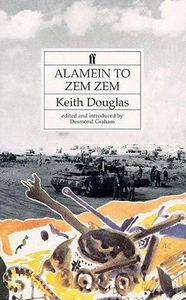Reilly 106.
Keith Douglas enlisted when World War II began, to fight and to try to make sense of history from within its turbulence. Like the major poets of World War I, his art was tried and tempered, and then curtailed. His letters tell the story of a man fully engaged by his art, his times and his loves.
Douglas is widely regarded as the finest soldier poet, writing in English, of the Second World War. In 1940, Douglas entered the army and trained as a cavalry officer at the Royal Military College, Sandhurst. In February 1941, he was commissioned into the 2nd Derbyshire Yeomanry and, by August, had arrived in the Middle East. After recovering from an ear infection in Palestine, he joined the cavalry regiment, the Sherwood Rangers Yeomanry, as a staff officer and was soon in the North African desert training for tank warfare. While the rest of the regiment was gearing up for action, Douglas was sent to Alexandria to teach camouflage and then to HQ at Wadi Natrun. On 23 October 1942, the battle of El Alamein began; after four days, Douglas could bear it no longer. Against orders, he left HQ, commandeered a lorry and joined his regiment in the desert – an action that, in less desperate times, could have led to court martial. But he went unpunished: the regiment had lost 16 of its 22 officers and needed reinforcements. It was Douglas's first taste of war and he found it exhilarating. On 15 January 1943, Douglas was wounded in action at Wadi Zem Zem, and was sent to Palestine to recover. During the six weeks he spent there, he began his unemotional narrative of the fighting – From Alamein to Zem Zem, which he later illustrated with fine paintings - and his first group of war poems. Released from hospital, Douglas rejoined his regiment in Egypt and, later, in Tunisia (where he was promoted to captain), but he took no further part in the fighting, which finally ended on 14 May 1943. On 6 April, he was moved to a top-security camp for final training in sea-borne invasion. Exactly two months later, he was in command of a tank troop in the main assault on Gold Beach in Normandy. The regiment helped liberate Bayeux and then, on D-Day + 3, arrived outside the little village of St Pierre. The 24-year-old Douglas and a comrade left their tank and walked towards the village, which was full of Germans. A mortar shell exploded directly above his head, killing him instantly without leaving a mark on his body. The chaplain buried him by a hedge near where he died.
